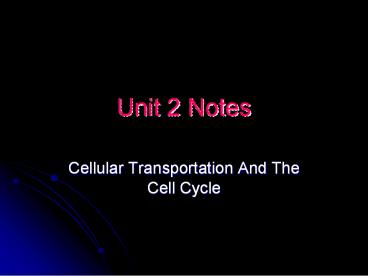Unit 2 Notes - PowerPoint PPT Presentation
1 / 42
Title:
Unit 2 Notes
Description:
Unit 2 Notes Cellular Transportation And The Cell Cycle Parts of Mitosis Cont Anaphase The centromeres split and the spindles pull the sister chromatids apart ... – PowerPoint PPT presentation
Number of Views:91
Avg rating:3.0/5.0
Title: Unit 2 Notes
1
Unit 2 Notes
- Cellular Transportation And The Cell Cycle
2
Cell Transportation 2 main types
- 1. Passive transport Does not require energy
from the cell - Moves downhill, with the concentration gradient
3
Cellular Transportation Type 2
- 2. Active Transport Requires energy to occur.
- Moves uphill, against the concentration gradient.
4
Passive Transport(No energy required)
- 3-Types
5
1st Type Passive Transport
- Simple Diffusion Movement of any substance
from areas of higher to lower concentrations - diffusion animation
6
2nd Type Passive Transport
- Osmosis Movement of water from areas of
higher to lower concentrations
7
3rd Type Passive Transport
- Facilitated diffusion Movement of substances
from higher to lower concentration with help from
a protein molecule - Animation How Facilitated Diffusion Works
8
2-Types of Active Transport (Energy Required)
- 1. Exocytosis The expulsion of particles from
the cell. - 2. Endocytosis surrounding and engulfing
particles. - Pinocytosis Cell drinking the cell takes in
liquids. - Phagocytosis Surrounding and taking in of large
particles.
9
Phagocytosis
- Animation Phagocytosis
10
Solute vs Solvent
- Solute The dissolved substance in a liquid.
- Solvent The liquid that the solute is dissolved
in Usually water
11
Types of solutionsIsotonic solution
- Concentrations of solute are equal in the cell
and the solution. (cellsolution) - Water moves back and forth at the same rate.
- Water in Water Out
12
Hyp-O-tonic solution(Hyp-Ohh no Im
swelling-tonic)
- HypOtonic Concentrations of solute are higher
in the cell than in the solution (cell-higher,
solution-lower) - Water moves into the cell.
- The cell swells and can burst.
13
Hypertonic Solution
- Concentrations of solute are lower in the cell
than in the solution (cell-lower,
solution-higher) - Water moves out of the cell.
- The cell shrinks.
14
Limits to cell size
- A cells size is limited, so organisms grow by
cellular division. - The cells of a baby are the same size as the
cells of an adult.
15
So Why Cant cells just grow larger???
16
Three factors that limit the growth of cells
- 1. Diffusion across cell surface.
- 2. Shortage of DNA.
- 3. Surface to volume ratio.
17
Diffusion
- Diffusion is efficient over short distances, but
becomes inefficient and slow over large
distances. - Socells that are large have a more difficult
time getting nutrients into the cell and waste
products out of the cell.
18
DNA
- A cell cannot survive without sufficient amounts
of DNA to make necessary proteins - Unusually large cells must have multiple nuclei
in order to supply needed DNA
19
Surface Area to Volume Ratio
- As a cells size increases, its volume increases
faster than its surface area
20
Cell Reproduction
- Mitosis Asexual reproduction (Cell Cycle)
- The process by which one cell divides into two
cells, both identical to the original parent cell
21
The Dreaded C Words!
- Chromatin
- Chromosomes
- Chromatid
- Centromeres
- Centrioles
22
Chromatin
- Relaxed DNA.
23
Chromosomes
- Condensed DNA.
- DNA that is preparing to undergo cellular
division - Can now be seen with a microscope.
24
Chromatids and Centromeres
- Sister Chromatids Halves of a duplicated parent
chromosome. - Centromeres The structure that joints two
sister chromatids.
25
Chromatin and Chromosome
26
Centrioles- Produce the spindle and aid in
replication
27
The Cell Cycle
- The process of asexual reproduction (mitosis) of
the cell - Contains three major parts
- 1. Interphase 2. Mitosis 3. Cytokinesis
28
The Cell Cycle
29
Part One of the Cell CycleInterphase
- The cell spends the majority of its life in
interphase. - A time in which the cell is preparing for
division.
30
Interphase3-Parts
- G-1 Maturation.
- S-Phase DNA replicates - makes a duplicate copy
of itself. - G-2 Organelles replicate and final preparations
for division.
31
Mitosis
- Division of the nucleus
- 4-phases
- Prophase
- Metaphase
- Anaphase
- Telophase
- PMAT
32
Parts of MitosisProphase
- The chromatin condense to form visible
chromosomes - The nuclear envelope begins to dissolve
- The centrioles divide and begin to migrate to
opposite sides of the cell
33
Parts of Mitosis ContMetaphase
- Centrioles have moved to opposite sides of the
cell - The spindle has formed
- Chromosomes are lined up in the middle of the
cell across the equator
34
Parts of Mitosis ContAnaphase
- The centromeres split and the spindles pull the
sister chromatids apart toward opposite sides of
the cell
35
Parts of Mitosis ContTelophase
- The chromosomes move to opposite sides of the
cell. - The nuclear envelope begins to reform around each
set of chromosomes at opposite sides of the cell.
36
Cytokinesis
- Division of the cytoplasm
- Begins to occur during telophase
- Different in plants and animal cells
37
Cytokinesis Cont
- Animal cells the plasma membrane pinches in to
form two separate cells - Plant cells A rigid cell plate begins to form
between the two new cells, dividing them and
becoming a cell wall.
38
(No Transcript)
39
mitosis animation
40
Control of the Cell Cycle
- The cell cycle is controlled by proteins and
enzymes - Contact with other cells causes cell to stop
dividing. - Cell stop dividing when they lose contact with
other cells
41
Cancer
- Uncontrolled cell growth resulting in tumors
- Metastasis Cells break lose and travel through
the circulatory system spreading throughout the
body.
42
Causes of Cancer
- Environmental factors that damage genes.
- Ex Cigarette smoke, UV rays from the sun, air
and water pollution, viruses































